Page 307 of 435
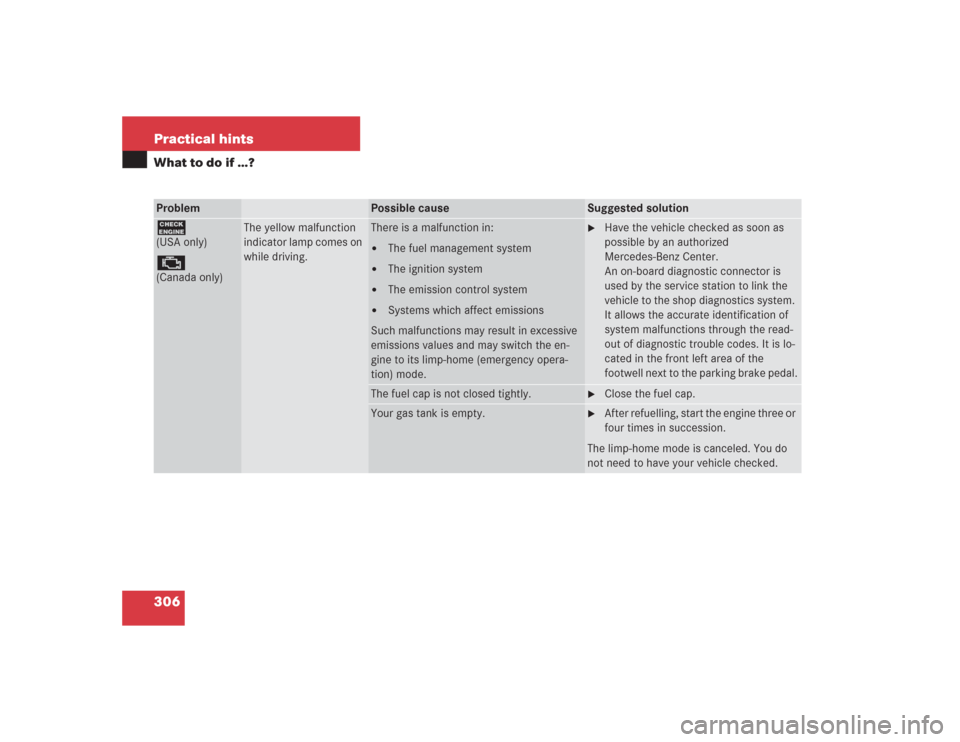
306 Practical hintsWhat to do if …?Problem
Possible cause
Suggested solution
?(USA only)±(Canada only)
The yellow malfunction
indicator lamp comes on
while driving.
There is a malfunction in:�
The fuel management system
�
The ignition system
�
The emission control system
�
Systems which affect emissions
Such malfunctions may result in excessive
emissions values and may switch the en-
gine to its limp-home (emergency opera-
tion) mode.
�
Have the vehicle checked as soon as
possible by an authorized
Mercedes-Benz Center.
An on-board diagnostic connector is
used by the service station to link the
vehicle to the shop diagnostics system.
It allows the accurate identification of
system malfunctions through the read-
out of diagnostic trouble codes. It is lo-
cated in the front left area of the
footwell next to the parking brake pedal.
The fuel cap is not closed tightly.
�
Close the fuel cap.
Your gas tank is empty.
�
After refuelling, start the engine three or
four times in succession.
The limp-home mode is canceled. You do
not need to have your vehicle checked.
Page 308 of 435
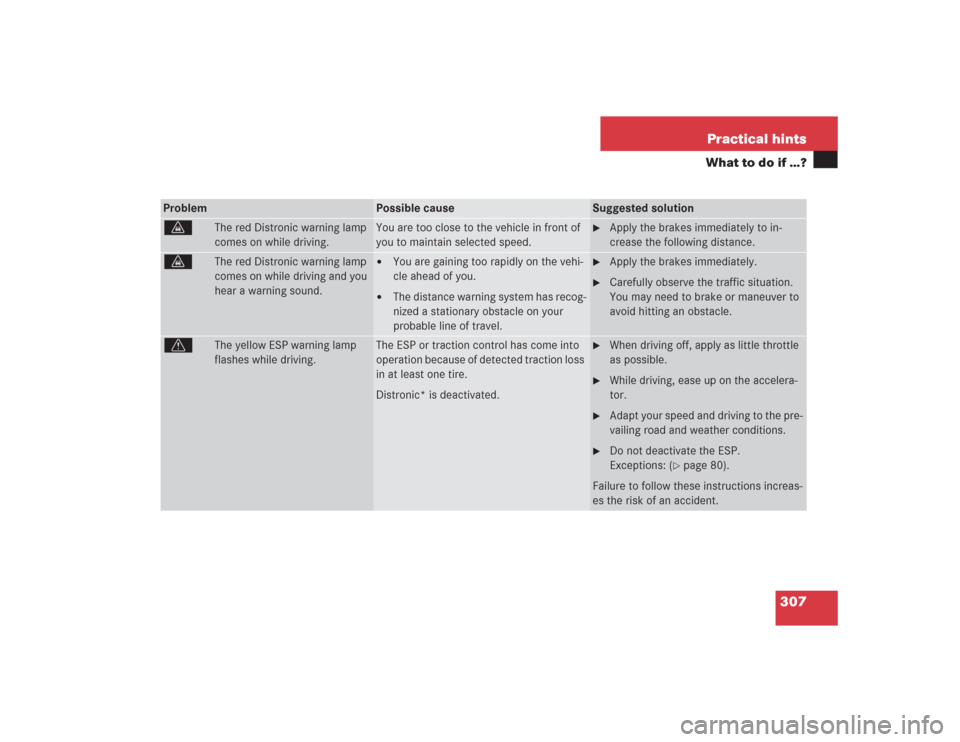
307 Practical hints
What to do if …?
Problem
Possible cause
Suggested solution
l
The red Distronic warning lamp
comes on while driving.
You are too close to the vehicle in front of
you to maintain selected speed.
�
Apply the brakes immediately to in-
crease the following distance.
l
The red Distronic warning lamp
comes on while driving and you
hear a warning sound.
�
You are gaining too rapidly on the vehi-
cle ahead of you.
�
The distance warning system has recog-
nized a stationary obstacle on your
probable line of travel.
�
Apply the brakes immediately.
�
Carefully observe the traffic situation.
You may need to brake or maneuver to
avoid hitting an obstacle.
v
The yellow ESP warning lamp
flashes while driving.
The ESP or traction control has come into
operation because of detected traction loss
in at least one tire.
Distronic* is deactivated.
�
When driving off, apply as little throttle
as possible.
�
While driving, ease up on the accelera-
tor.
�
Adapt your speed and driving to the pre-
vailing road and weather conditions.
�
Do not deactivate the ESP.
Exceptions: (
�page 80).
Failure to follow these instructions increas-
es the risk of an accident.
Page 315 of 435
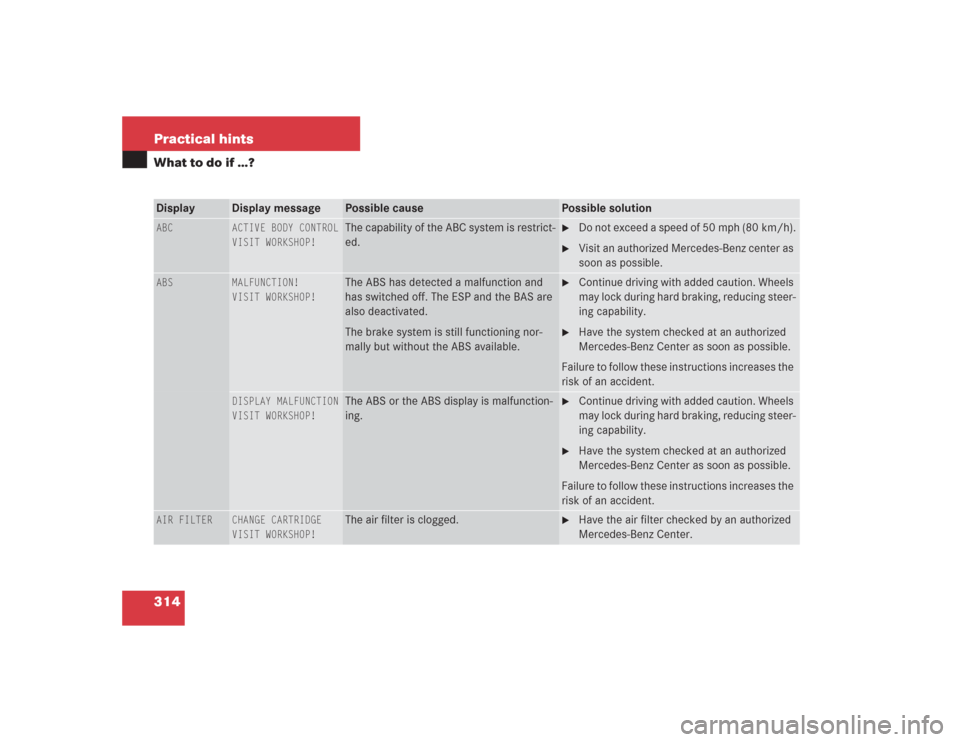
314 Practical hintsWhat to do if …?Display
Display message
Possible cause
Possible solution
ABC
ACTIVE BODY CONTROL
VISIT WORKSHOP!
The capability of the ABC system is restrict-
ed.
�
Do not exceed a speed of 50 mph (80 km/h).
�
Visit an authorized Mercedes-Benz center as
soon as possible.
ABS
MALFUNCTION!
VISIT WORKSHOP!
The ABS has detected a malfunction and
has switched off. The ESP and the BAS are
also deactivated.
The brake system is still functioning nor-
mally but without the ABS available.
�
Continue driving with added caution. Wheels
may lock during hard braking, reducing steer-
ing capability.
�
Have the system checked at an authorized
Mercedes-Benz Center as soon as possible.
Failure to follow these instructions increases the
risk of an accident.
DISPLAY MALFUNCTION
VISIT WORKSHOP!
The ABS or the ABS display is malfunction-
ing.
�
Continue driving with added caution. Wheels
may lock during hard braking, reducing steer-
ing capability.
�
Have the system checked at an authorized
Mercedes-Benz Center as soon as possible.
Failure to follow these instructions increases the
risk of an accident.
AIR FILTER
CHANGE CARTRIDGE
VISIT WORKSHOP!
The air filter is clogged.
�
Have the air filter checked by an authorized
Mercedes-Benz Center.
Page 322 of 435
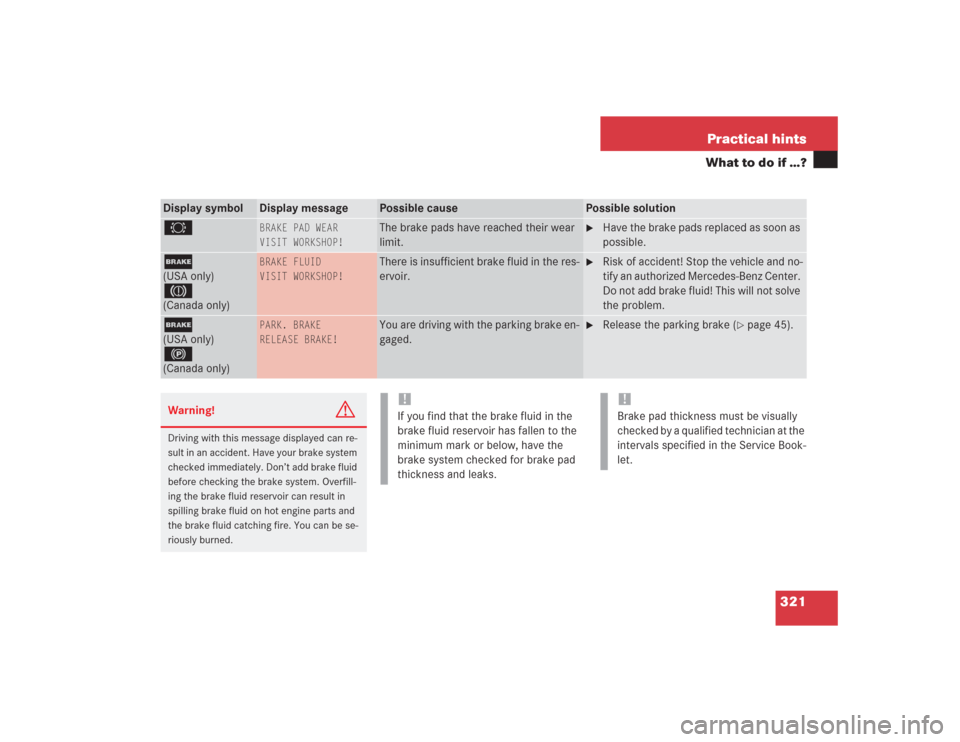
321 Practical hints
What to do if …?
Display symbol
Display message
Possible cause
Possible solution
2
BRAKE PAD WEAR
VISIT WORKSHOP!
The brake pads have reached their wear
limit.
�
Have the brake pads replaced as soon as
possible.
;(USA only)3(Canada only)
BRAKE FLUID
VISIT WORKSHOP!
There is insufficient brake fluid in the res-
ervoir.
�
Risk of accident! Stop the vehicle and no-
tify an authorized Mercedes-Benz Center.
Do not add brake fluid! This will not solve
the problem.
;(USA only)!(Canada only)
PARK. BRAKE
RELEASE BRAKE!
You are driving with the parking brake en-
gaged.
�
Release the parking brake (
�page 45).
Warning!
G
Driving with this message displayed can re-
sult in an accident. Have your brake system
checked immediately. Don’t add brake fluid
before checking the brake system. Overfill-
ing the brake fluid reservoir can result in
spilling brake fluid on hot engine parts and
the brake fluid catching fire. You can be se-
riously burned.
!If you find that the brake fluid in the
brake fluid reservoir has fallen to the
minimum mark or below, have the
brake system checked for brake pad
thickness and leaks.
!Brake pad thickness must be visually
checked by a qualified technician at the
intervals specified in the Service Book-
let.
Page 330 of 435
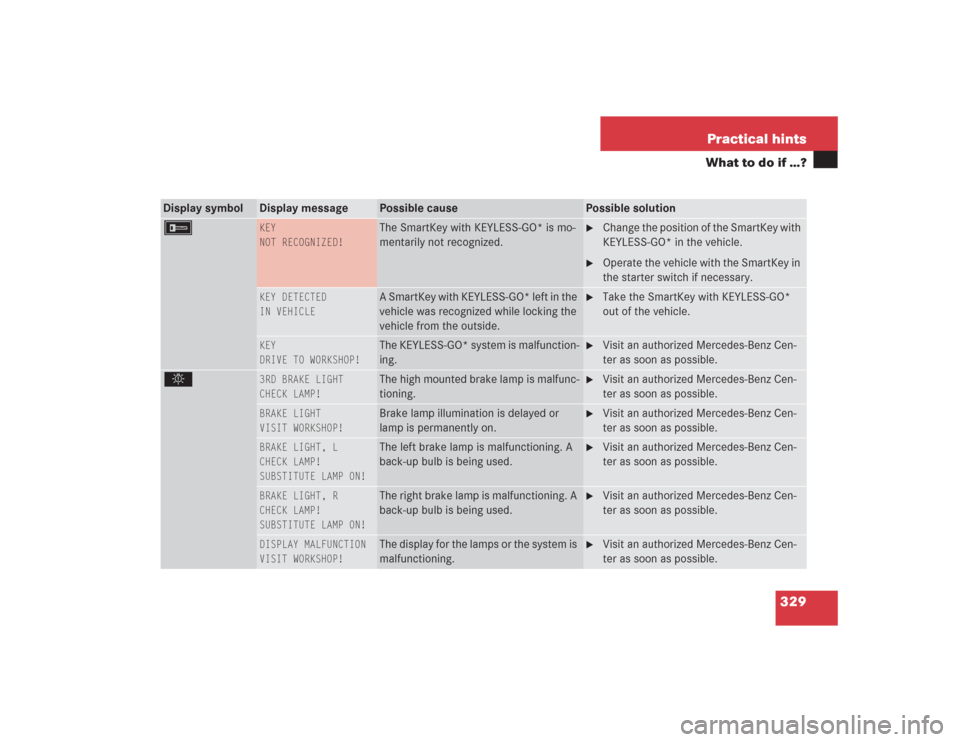
329 Practical hints
What to do if …?
Display symbol
Display message
Possible cause
Possible solution
F
KEY
NOT RECOGNIZED!
The SmartKey with KEYLESS-GO* is mo-
mentarily not recognized.
�
Change the position of the SmartKey with
KEYLESS-GO* in the vehicle.
�
Operate the vehicle with the SmartKey in
the starter switch if necessary.
KEY DETECTED
IN VEHICLE
A SmartKey with KEYLESS-GO* left in the
vehicle was recognized while locking the
vehicle from the outside.
�
Take the SmartKey with KEYLESS-GO*
out of the vehicle.
KEY
DRIVE TO WORKSHOP!
The KEYLESS-GO* system is malfunction-
ing.
�
Visit an authorized Mercedes-Benz Cen-
ter as soon as possible.
.
3RD BRAKE LIGHT
CHECK LAMP!
The high mounted brake lamp is malfunc-
tioning.
�
Visit an authorized Mercedes-Benz Cen-
ter as soon as possible.
BRAKE LIGHT
VISIT WORKSHOP!
Brake lamp illumination is delayed or
lamp is permanently on.
�
Visit an authorized Mercedes-Benz Cen-
ter as soon as possible.
BRAKE LIGHT, L
CHECK LAMP!
SUBSTITUTE LAMP ON!
The left brake lamp is malfunctioning. A
back-up bulb is being used.
�
Visit an authorized Mercedes-Benz Cen-
ter as soon as possible.
BRAKE LIGHT, R
CHECK LAMP!
SUBSTITUTE LAMP ON!
The right brake lamp is malfunctioning. A
back-up bulb is being used.
�
Visit an authorized Mercedes-Benz Cen-
ter as soon as possible.
DISPLAY MALFUNCTION
VISIT WORKSHOP!
The display for the lamps or the system is
malfunctioning.
�
Visit an authorized Mercedes-Benz Cen-
ter as soon as possible.
Page 336 of 435
335 Practical hints
What to do if …?
Tire pressure monitor messages
(vehicles produced up to approximately
October 2003)Display symbol
Display message
Possible cause
Possible solution
H
TIRE PRES.
DISPLAY AFTER DRIVING
A FEW MINS. REACTIVATE
USING R-BUTTON
The tire pressure is being checked.
TIRE PRES. MONITOR
NOT ACTIVE
The tire inflation pressure monitor* is un-
able to monitor the tire pressure due to�
the presence of several wheel sensors
in the vehicle.
�
excessive wheel sensor tempera-
tures.
�
a nearby radio interference source.
�
unrecognized wheel sensors mount-
ed.
�
Check the tire pressure at the next ser-
vice station.
Warning!
G
Do not drive with a flat tire. A flat tire affects
the ability to steer or brake the vehicle.
You may lose control of the vehicle. Contin-
ued driving with a flat tire will cause exces-
sive heat build-up and possibly a fire.
Page 337 of 435

336 Practical hintsWhat to do if …?Display symbol
Display message
Possible cause
Possible solution
H
TIRE PRES. MONITOR
REACTIVATE!
The tire inflation pressure monitor* is de-
activated.
�
Activate the tire inflation pressure mon-
itor* (
�page 286).
TIRE PRES. MONITOR
VISIT WORKSHOP!
The tire inflation pressure monitor* is
malfunctioning.
�
Have the tire inflation pressure moni-
tor* checked by an authorized
Mercedes-Benz Center.
�
Change the wheel (
�page 361).
A wheel without proper sensor was in-
stalled.
�
Check and correct tire pressure as re-
quired (
�page 283).
TIRE PRES.
CAUTION, TIRE DEFECT!
One or more tires are deflating.
�
Carefully bring the vehicle to a halt,
avoiding abrubt steering and braking
maneuvers.
�
Change the wheel (
�page 361).
TIRE PRES.
CHECK TIRES!
The tire pressure in one or more tires is
already below the minimum value.
The tire pressure in one or more tires is
low.
�
Carefully bring the vehicle to a halt,
avoiding abrubt steering and braking
maneuvers.
�
Change the wheel (
�page 361).
Warning!
G
Do not drive with a flat tire. A flat tire affects
the ability to steer or brake the vehicle.
You may lose control of the vehicle. Contin-
ued driving with a flat tire will cause exces-
sive heat build-up and possibly a fire.
Page 338 of 435
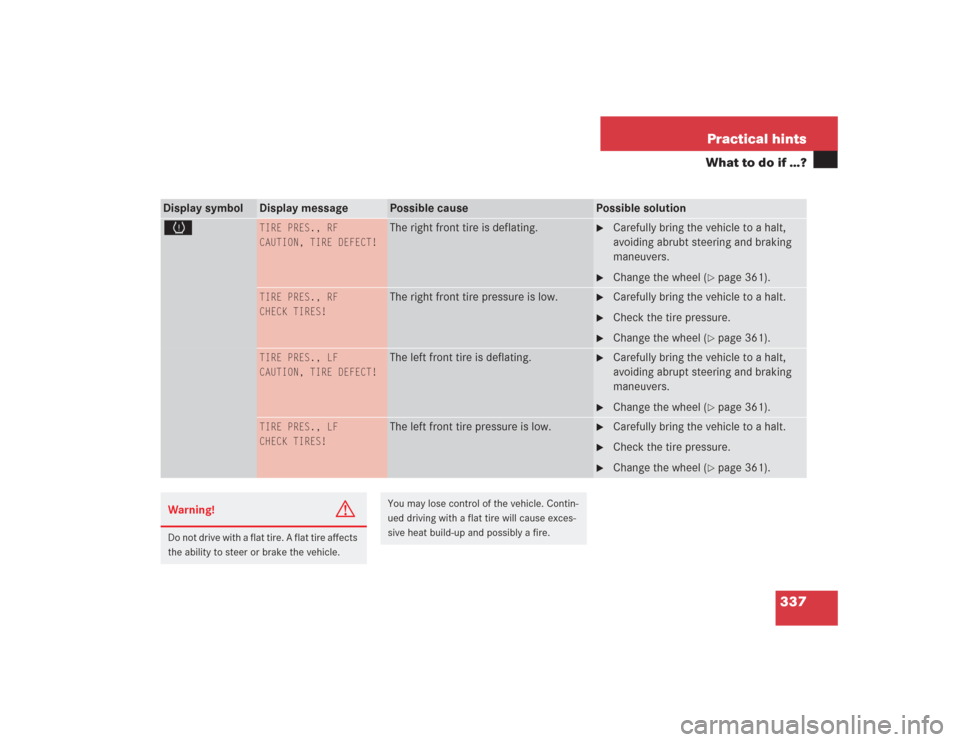
337 Practical hints
What to do if …?
Display symbol
Display message
Possible cause
Possible solution
H
TIRE PRES., RF
CAUTION, TIRE DEFECT!
The right front tire is deflating.
�
Carefully bring the vehicle to a halt,
avoiding abrubt steering and braking
maneuvers.
�
Change the wheel (
�page 361).
TIRE PRES., RF
CHECK TIRES!
The right front tire pressure is low.
�
Carefully bring the vehicle to a halt.
�
Check the tire pressure.
�
Change the wheel (
�page 361).
TIRE PRES., LF
CAUTION, TIRE DEFECT!
The left front tire is deflating.
�
Carefully bring the vehicle to a halt,
avoiding abrupt steering and braking
maneuvers.
�
Change the wheel (
�page 361).
TIRE PRES., LF
CHECK TIRES!
The left front tire pressure is low.
�
Carefully bring the vehicle to a halt.
�
Check the tire pressure.
�
Change the wheel (
�page 361).
Warning!
G
Do not drive with a flat tire. A flat tire affects
the ability to steer or brake the vehicle.
You may lose control of the vehicle. Contin-
ued driving with a flat tire will cause exces-
sive heat build-up and possibly a fire.